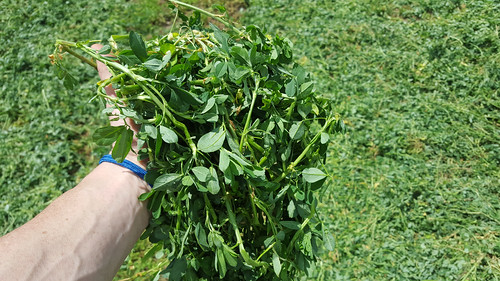Bloat in cattle – How real is the risk?
May 18, 2018
By Sarah Cato
U of A System Division of Agriculture
Fast facts
- Bloat can be caused by grazing certain forages
- Causes suffocation of the animal
- Prevention and avoidance is key
(535 words)
(Newsrooms - photo downloadable here: https://flic.kr/p/26aaqmU )
Download Word version
LITTLE ROCK – Bloat in cattle is a seasonal problem for producers which can be caused by grazing forage such as certain legumes and to a lesser extent by the fresh growth of winter annual cereals and leafy forages such as turnips.
Dirk Philipp, associate professor-forages for the University of Arkansas System Division of Agriculture, says bloat is caused by gas build up in the rumen.

“Bloat is caused by the development of frothy liquid in the rumen. If gases build up in the rumen and create a stable foam, they push against the diaphragm which will suffocate the animal by keeping the diaphragm from being able to move air in and out of the lungs,” Philipp said.
Prevention
“The window to catch an animal with bloat and remove from a paddock is very narrow,” Philipp said, “so the focus should be on prevention.”
Forages that carry a risks for inducing bloat include:
- Alfalfa.
- Red and white clover.
- Crimson clover.
- Cereal crops.
- Brassicas, such as turnips.
Philipp said these forages may pose a risk because of their high level of digestibility and low level of dry matter at certain times during their growing cycle.
“These forages are all highly digestible,” he said. “Rumen microbes have access to the protein in these forages very easily. When these microbes digest the forage they release gas, which builds up in the cow’s rumen. This gas mixes with liquids, which is how the froth and stable foam develops.”
These high-risk forages all occur in Arkansas, but most of the time they do not cause a problem.
“Clovers don’t really persist well in Arkansas and normally these forages are grazed in conjunction with other non-bloating forages,” Philipp said, “and the total amount of these forages is normally relatively small in pastures.”
Along with identifying high-risk forages, producers should also be aware that bloat is animal specific and depends on environmental factors.
“Day temperatures around 70 degrees and cool overnight temperature will lead to a higher risk,” Philipp said, as these are good growing conditions for higher-risk forages, “and high soil moisture, which leads to high plant moisture, will also increase risk. High plant moisture relates to lush forage with low dry matter values. Lower dry matter means higher risk because the percentage of protein will be higher in relation to fiber.”
Fields of entirely clovers or alfalfa are definitely at risk if:
- Growth is lush and fresh such in spring.
- Growth is young and little mature.
- Plant moisture is high.
- Cattle are moved onto the pasture with an “empty stomach.”
Tips to avoid bloat:
- Never move cattle hungry on pastures with high risk forages or growth.
- Feed hay (roughage) along with high risk forages.
- Hay will induce salivation and production of mucin that helps prevent foaming.
- Stock animals rotationally for short amounts of time only, especially when bloat risks are high, this way they don’t return repeatedly to the youngest and freshest growth.
- Monitor animals closely.
- If you live in an area where legumes persist, establish grass-legume mixes.
- Products such as ‘Bloat Guard’ are helpful, but don’t rely on them solely.
Product names mentioned in this story do not imply endorsement by the University of Arkansas System Division of Agriculture.
For more information about cattle and forage production, contact your county extension office or visit www.uaex.uada.edu.
About the University of Arkansas System Division of Agriculture
The University of Arkansas System Division of Agriculture’s mission is to strengthen agriculture, communities, and families by connecting trusted research to the adoption of best practices. Through the Agricultural Experiment Station and the Cooperative Extension Service, the Division of Agriculture conducts research and extension work within the nation’s historic land grant education system.
The Division of Agriculture is one of 20 entities within the University of Arkansas System. It has offices in all 75 counties in Arkansas and faculty on five system campuses.
Pursuant to 7 CFR § 15.3, the University of Arkansas System Division of Agriculture offers all its Extension and Research programs and services (including employment) without regard to race, color, sex, national origin, religion, age, disability, marital or veteran status, genetic information, sexual preference, pregnancy or any other legally protected status, and is an equal opportunity institution.
# # #
Media Contact: Mary Hightower
Dir. of Communication Services
U of A System Division of Agriculture
Cooperative Extension Service
(501) 671-2126
mhightower@uada.edu